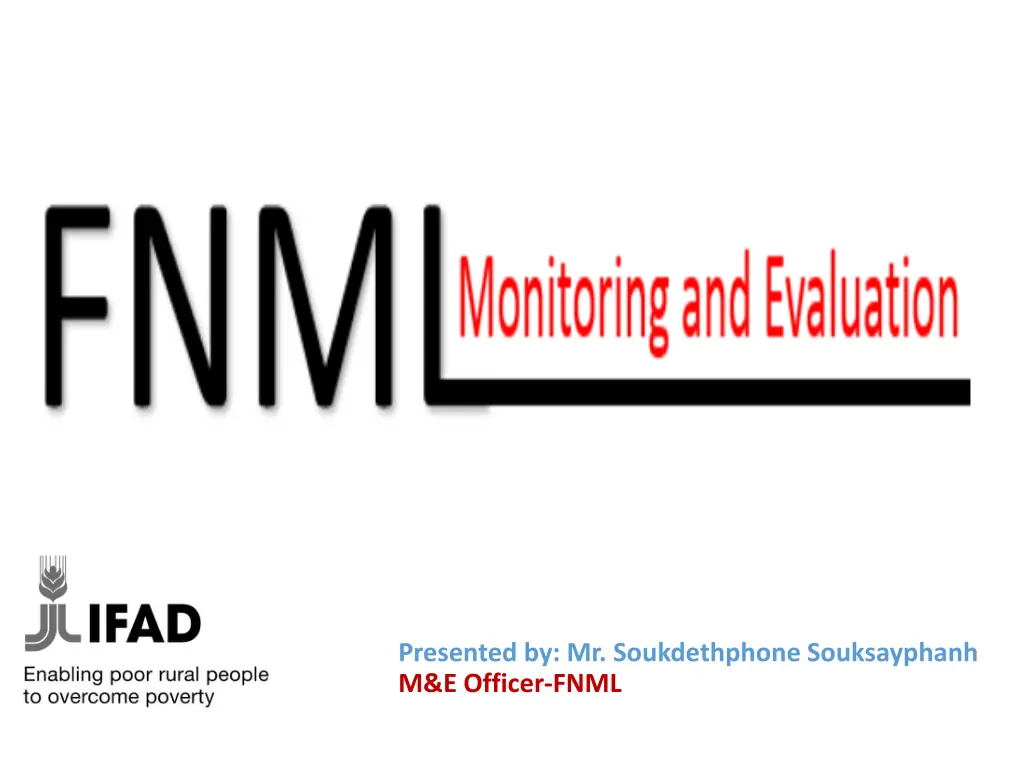
M&E System for Sustainable Development
"Explore a detailed M&E system managed by Mr. Soukdethphone Souksayphanh, focusing on goals to reduce poverty, improve food security, and enhance financial services. Components include food & nutrition security, rural finance support, and institutional capacity building."
Download Presentation

Please find below an Image/Link to download the presentation.
The content on the website is provided AS IS for your information and personal use only. It may not be sold, licensed, or shared on other websites without obtaining consent from the author. If you encounter any issues during the download, it is possible that the publisher has removed the file from their server.
You are allowed to download the files provided on this website for personal or commercial use, subject to the condition that they are used lawfully. All files are the property of their respective owners.
The content on the website is provided AS IS for your information and personal use only. It may not be sold, licensed, or shared on other websites without obtaining consent from the author.
E N D
Presentation Transcript
Presented by: Mr. Soukdethphone Souksayphanh M&E Officer-FNML
M&E System M&E System - The M&E system managed with systems detailed below: Logical framework RIMS Programme planning Data collection Analysis Reporting
indicators Logframe Logframe indicators Narrative Summary Objectively Verifiable Indicators Goals: Contribute to reduce extreme poverty and hunger 90% of 10,500 HH out of Poverty At least 50% of HH with improved food security 20% reduction in child malnutrition Household assets index increased by at least 50% 60% of target households report 50% increase in the agricultural output of diversified food crops and key cash crop products. At least 30% increase in home garden nutritional food consumption 50% increase of number of HHs accessing financial services 50% of target HHs have entered into a successful PPP Development Objective: Ensure sustainable food security, nutrition and income of households in the target area. Component 1 - Food and Nutrition Security and Pro Poor Market Access. At least 85% of HH adopts support services. At least 50% of HH whom adopt support service are women. At least 50% of HH adopts improved techniques At least 50% of HH whom adopt improved techniques are women 2000 days of farmer to farmer extension (50% women; 50% men) At least 85% of HH demonstrate improved knowledge in nutritional home gardening (80% women; 20% men) At least 80% of HH demonstrate improved knowledge in nutritional home gardening are women. 60 drinking water supply schemes. Target group farmers enhance the diversity, productivity and quality of selected food and cash crops and they have fair and remunerative accessto markets for selected commodities. Component 2 - Inclusive Rural Finance Support Target group farmers access financial services and receive trainings to improve their capacity to market and sell their products. Component 3 - Institutional Support Capacity of value chains players is built Policy measures are designed and communicated to relevant national stakeholders New group lending prudential rules available for farmer groups and Partner Banks At least one potential partner bank has joined the Programme Each of the 175 target villages has received general information and basic training in accessing a group loan and matching grant. At least 50 villages received matching grants for joint investments in marketing facilities At least ten Programme Business Partners provide services and trade in target villages. At least one meeting/year organized between all stakeholders in each of the three value chanins. 3 studies on value chain development implemented and results channelled to SWG ARD
RIMS RIMS Baseline survey Endline survey 25 16 14 20 12 10 15 8 10 6 4 5 2 0 0 Baseline survey Baseline survey Endline survey
planning Programme Programme planning Programme planning cycle implemented with following steps: PRA and VDP (Village level) Prepared AWPB at district level (District WS for district committee approval) Prepared AWPB at provincial and regional level (Provincial and regional WS and submit to the regional committee for approval) Submitted AWPB to MAF and IFAD for final approval
Data Data collection collection Data collection of programme covered by direct and indirect beneficiaries of activities implemented all component (number of hose hold, people, ethnic, women, group, system built) along three level 3 2 Provincial and regional level 1 District level Household and village level
Analysis Analysis Consolidated and analysed of data from different sources so as to provide information on the performance of the various component, Analysis measured detect problems, identify possible solutions and track good practices to share through the knowledge management system
Reporting Reporting Programme reporting cycle was detailed below: District level Brief monthly, quarterly report by districts Mainly report consisting of the record of activities, output and financial transaction PAFOs and PRCO level Consolidated quarterly report Consolidated biannual and annual report PRCO will be prepare PCR within three months after completion programme
reports Types of M&E data and Types of M&E data and reports In terms of data, there will be the following data: RIMS Surveys, Annual Outcome Surveys Photo Story Book, Analytical Studies AWBP, M&E database In terms of reports, the M&E needs to store the following types of reports: Project Design Documents Aide Memoire of the supervision missions RIMS Progress Reports Project Completion Reports Annual progress Report Physical Progress Report
THANK YOU THANK YOU
